May 29, 1903
On a warm spring day in 1903, Montclair High School hosted what appears to have been the first-ever women’s dual track meet. Prior to this event, other schools had held track and field competitions for women—most notably Vassar College, which had an annual Field Day—but the official head-to-head competition between Montclair and the visiting Pamlico School for Girls (aka Pompton Athletic Association) team was the first of its kind between female athletes in the United States.
Gertrude Giffen of Montclair was the star of the day. She finished first in the 50- and 75-yard dashes and the high jump , and second in the shot put. Giffen also ran the final leg for Montclair’s winning 300-yard relay team. Marie Richards of Pamlico won the long jump with a distance of 14’ 3”. In 1904, Spalding listed women’s track and field records in its annual guide for the first time. Giffen’s time in the 75-yard dash was 10.4 seconds. Her time in the 50 was 7 seconds flat.
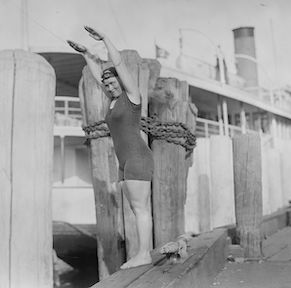
September 20, 1914
In the early years of the 20th century, one of the most exciting and elusive accomplishments in sports was completing a 22-mile swim from Battery Park in Manhattan to Ft. Hancock in Sandy Hook. The first person to make it was Samuel Richards, in 7 hours, 18 minutes, in 1913. One year later, Nell Kenney (left) of Australian became the first woman to complete the swim. The strong tides and current dragged Kenney far off course—up the East River past the Brooklyn Bridge at one point—but she still managed to make it in under 10 hours. She left New York at 7:50 a.m. and arrived at Sandy Hook at 5:25 p.m.
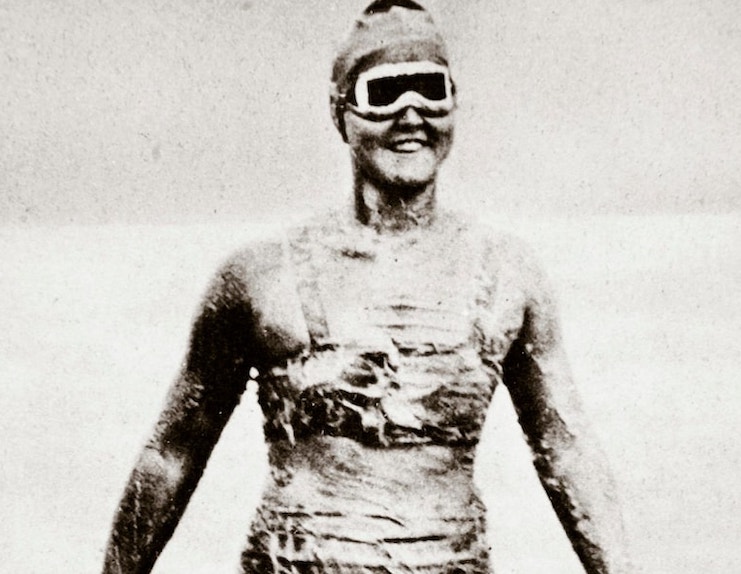
Eleven years later, Gertrude Ederle (right) completed the same swim with a new record of 7 hours, 11 minutes. Ederle’s record convinced her to attempt a crossing of the English Channel. Her first attempt fell short but, in 1926, Ederle became the first woman to complete the journey from France to England.
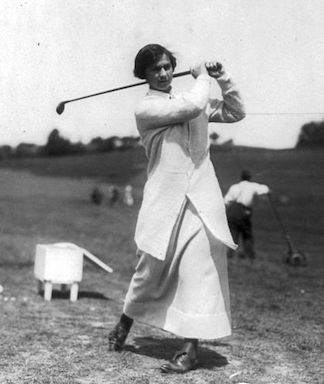
October 8, 1921
Marion Hollins (left) defeated Alexa Stirling in the finals of the 1921 USGA Women’s Amateur Championship 5 & 4. The event was held at the Hollywood Golf Club, newly redesigned by Walter Travis. Stirling was a three-time defending champion. Hollins, the tournament’s runner-up at age 20 in 1913, captured the title eight years later.
The daughter of Wall Street magnate H.B. Hollins, Marion was keenly interested in golf course design. She went on to develop three renowned courses, including Cypress Point in Pebble Beach. She hired Alister McKenzie to design the course, and did much to convince Bobby Jones to hire McKenzie to lay out Augusta National.
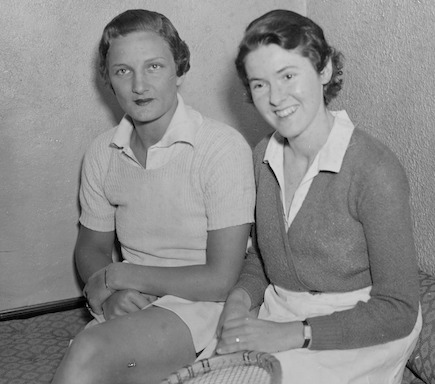
July 29, 1933
There is no such thing as a “lock” in singles tennis, but heading into the women’s final of the 1933 Sea Bright Lawn Tennis Invitational, Helen Jacobs (left) was as close as it comes. She had won the summer warm-up for Forest Hills three years running, and despite some lightheadedness in the semifinal, she took the court against young Sarah Palfrey (right) supremely confident.
Jacobs was the reigning US singles champion and top-ranked player in the nation. She also made headlines by wearing shorts in her matches—a new fashion trend she pioneered. Palfrey’s lone advantage in the match was that she was Jacobs’s sometimes doubles partner; they had played together and won at Forest Hills in 1932. But at age 20, the inexperienced Massachusetts native did not even rank in the Top 10 nationally.
Palfrey came out like a buzzsaw and took the first set, 6–1. Jacobs regained control of the match with a 6–2 win in the second set. However, Palfrey regrouped and hung in the deciding set to pull even at 5–5—and took the next two games to win the match.
Jacobs shook off the loss to defend her US singles title, and ended up winning at Forest Hills in 1934 and 1935 to make it four in a row. In the 1950s, she returned to Sea Bright and served as the club’s tennis pro. As for Palfrey, her time would come in 1941, when she earned the #1 U.S. ranking as Sarah Palfrey Cooke with a win at Forest Hills. She won again in 1945, becoming just the second mom to claim the US singles championship.
September 25, 1937
When the Women’s Track & Field Championships opened at Trenton Central High School in the autumn of 1937, much of the talk surrounded the absence of Helen Stephens and Stella Walsh, the two dominant American track athletes of 1936. Stephens had retired from competition the previous spring and Walsh was still smarting from accusations that she was a man disguised as a woman. Both athletes, whose “masculine features” concerned Olympic officials, were made to undergo humiliating genital inspections after receiving their medals.
By the end of the day in Trenton, there was a lot more to talk about. Cleve Abbott’s seven-member team was crowned national champions—a first for an entrant with an African-American athlete in uniform.
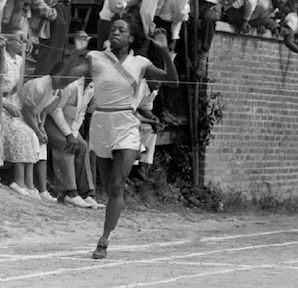
Only it wasn’t one athlete. It was all seven. And the uniform they were wearing was from the Tuskegee Institute in Alabama. Abbott had only started the school’s track team the year before so his daughter, Jessie, could compete. The Tuskegee squad had come to the Olympic Trials in 1936 and won a handful of non-Olympic events. The confidence they gained showed in 1937, when their 33 points were double that of their nearest competitor. Cora Gaines won the 80-meter hurdles and Lula Hymes (left) won the broad jump, leading a team that picked up points with strong finishes in every event but the javelin.
If anyone doubted that the Tuskegee women were a one-off fluke, they were dissuaded by the performance of the second-place Mercury Athletic Club. Mercury AC, led by sprinter Esther Dennis and Gertrude Johnson, was an all-black contingent.
The Tuskegee women’s track team would win the national outdoor team championship the following year, and 12 more times between 1939 and 1951—including the 1940 and 1941 meets, which were held in Ocean City, New Jersey. Abbott’s team also won the national indoor titles in in 1941, ’45, ’46 and ’48. Abbott’s Olympic gold medalists included high jumpers Alice Coachman and Mildred McDaniel.
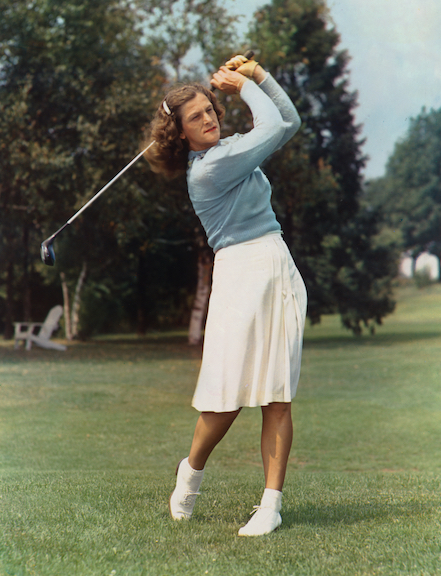
August 15, 1948
Women’s professional golf was in its infancy when the Atlantic City Country Club hosted the third US Women’s Open. The formation of the LPGA was still two years away. The driving force behind the sport was Babe Didrikson Zaharias, a former Olympic track & field gold medalist and basketball All-American who had won the US Amateur title in 1946 and was the AP Female Athlete of the Year three years running.
Poor weather plagued the golfers during the four-round event, and Babe was the only golfer to play at even par. The 37-year-old cruised to an eight-shot victory over Betty Hicks, but ended the tournament disappointed. A club member had offered $1,000 to anyone who could break event par (300) and Babe just needed to hole a 5-foot putt on the 72nd hole to win the money. She lipped out, but still took home $1,200 for her victory.
May 2, 1976
In 1977, Janet Guthrie became the first female driver to make the starting field at the Indianapolis 500. She had been driving open-wheel Indy cars for just over a year and, in fact, had attempted to qualify at the Brickyard in 1976 but did not make the starting field. Less than four weeks prior to this unsuccessful qualifying bid, , on May 2nd, Guthrie got her first ride on the USAC Champ Car circuit at the Trenton 200. The Trenton Speedway, a 1.5-mile track shaped like a kidney bean, had been an important stop on both the USAC and NASCAR circuits since the 1960s.
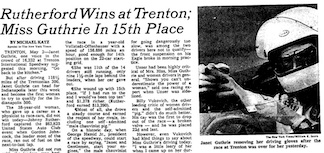
Guthrie, an aerospace engineer turned race car driver, started the 1976 Trenton 200 in 14th place driving car #17, owned by Rolla Vollstedt and sponsored by Bryant Heating. In the first half of the race, she sped past AJ Foyt as he blew an engine and was within striking distance of top finishers Johnny Rutherford, Gordon Johncock and Tom Sneva when her gearbox failed on the 79the lap, finishing 15th.
Four weeks later, on May 30th—after Guthrie’s unsuccessful Indy 500 bid—Winston Cup owner Humpy Wheeler offered her a chance to qualify for the World 600 at the Charlotte Motor Speedway. This she did, on the 9th row, and thus became the first woman to drive in a NASCAR superspeedway race. It was a busy May, to say the least!
Although the result at the Trenton 200 was not what Guthrie had hoped for, it earned her the deep respect of Vollstedt, a noted innovator. It was he who hired her to drive for him in the Indy 500 in 1977.
For the record, Guthrie started the 1977 Indy 500 on the 9th row again and finished 29th after a pit mishap showered her with racing fuel and her timing gear later failed. Finding her a place to shower off the gasoline proved to be a challenge, as there was no women’s locker room in the garage area.
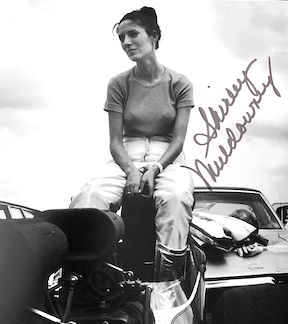
July 16, 1977
Racing fans had never seen anything like Shirley Muldowney (right). After winning her first Top Fuel series victory in 1976, she took the NHRA by storm in 1977 to become the first woman to capture the Top Fuel World Championship. The victory that catapulted her into a commanding Winston points lead took place at Raceway Park in Old Bridge during the Summer Nationals. (She sewed up the title with another major win that summer, in Montreal.) That fall, Congress honored Muldowney with its Outstanding Achievement award.
Her 1977 title was no fluke—she won the Top Fuel crown again in 1980 and 1982.
July 28, 1987
During the 1970s and 1980s, the LPGA gained unprecedented prestige and power. Yet women’s pro golf was viewed as an “American” sport, which hampered its international appeal. For women’s golf to truly go global, it needed a defining overseas champion.
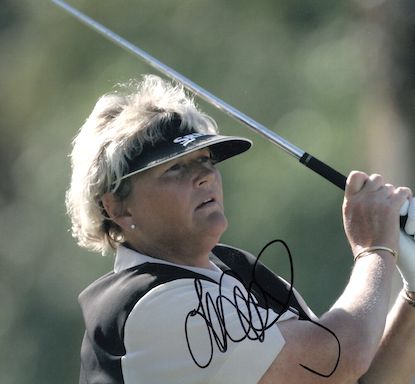
At the 1987 US Open at the Plainfield Country Club, 23-year-old Laura Davies (right) of England assumed that transformative role. Davies, not yet an LPGA member but still the game’s most powerful player off the tee, stunned the crowds with her monster drives. She went toe-to-toe with old pro Joanne Carner during the tournament—no slouch when it came to the power game—and also Japan’s Ayako Okamoto, a graceful and athletic golfer who stayed in the hunt with her finesse. Lurking behind this trio was the sensational Nancy Lopez.
The tension heightened on the final day, when rain halted the last round after two-thirds of the field had begun play. A scintillating final round on Monday found Davies, Carner and Okamato tied after 72 holes. During the 18-hole playoff on Tuesday, Davies finally seized control with birdies on 14 and 15 to win the Open by two strokes over Okamoto and three over Carner. Davies was not the first foreign winner of the US Open, but her victory opened the flood gates to foreign golfers who won or contended for the championship almost every year thereafter.
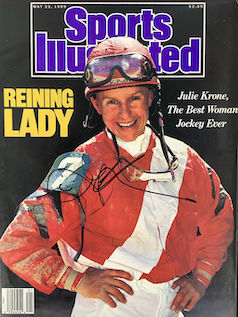
August 20, 1987
Julie Krone was the acknowledged queen of Monmouth Park in the summer of 1987. On a balmy Thursday afternoon, she tied a track record with six victories in 10 tries. The 24-year-old jockey won each of her first four races: on Able Cable, Play It Hard, Wondecor and Waltzing Empress. Krone won the 7th race aboard Hendeka. Victory number 6 came in the day’s feature race atop Rita H.
Krone’s final win of the day was also the 100th of her career at Monmouth. Only six others (all men) had reached that plateau before her. Krone was named track champion at Monmouth, Atlantic City and the Meadowlands that year, becoming the first female jockey to win a championship at a major track—three times over.